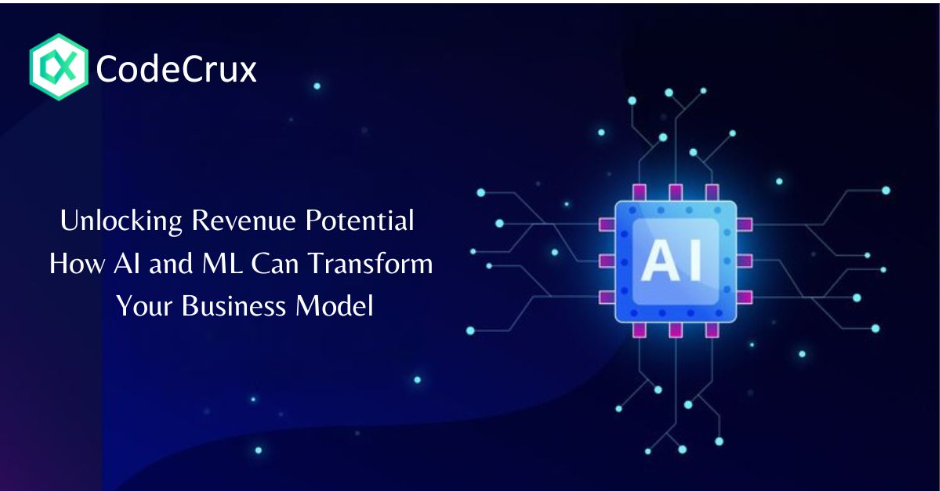How AI and ML Can Transform Your Business

Artificial Intelligence (AI) and Machine Learning (ML) have emerged as game-changers, offering solutions that can unlock new revenue streams and fundamentally reshape business models.
The Rise of AI and ML in Business
AI and ML are no longer futuristic concepts; they have become integral to modern business strategies. From automating routine tasks to generating actionable insights from vast amounts of data, these technologies are enabling companies to make smarter decisions, improve efficiencies, and create personalised customer experiences.
Key Areas Where AI and ML Can Transform Business Models
1. Personalization and Customer Experience
AI and ML can analyse customer behaviour, preferences, and interactions to deliver hyper-personalised experiences. Whether it’s recommending products, offering tailored services, or providing targeted content, personalization drives customer loyalty and boosts sales. This approach helps businesses create unique, value-driven relationships with their customers, increasing retention and lifetime value.
2. Operational Efficiency and Cost Reduction
AI-powered automation can streamline operations by handling repetitive tasks such as data entry, customer support, and supply chain management. ML algorithms can also predict demand, manage inventory, and optimise logistics, reducing waste and improving overall efficiency. This not only cuts costs but also frees up human resources to focus on strategic, high-value tasks.
3. Data-Driven Decision Making
AI and ML can process and analyse large datasets in real-time, uncovering patterns and trends that may not be immediately apparent to human analysts. These insights help businesses make informed decisions about market trends, customer preferences, and operational adjustments, leading to better outcomes. Predictive analytics, a key application of ML, can forecast future market conditions, enabling proactive strategies rather than reactive ones.
4. New Revenue Streams through AI-Driven Products
Businesses can create entirely new revenue streams by developing AI-based products and services. For example, AI can be used to offer predictive maintenance solutions in manufacturing, smart assistants in customer service, or personalised financial advice in fintech. By leveraging AI to introduce innovative offerings, companies can diversify their portfolios and tap into new market opportunities.
5. Enhancing Marketing and Sales Strategies
AI can revolutionise marketing by providing deeper insights into consumer behaviour. From segmenting audiences more accurately to optimising ad spend and improving conversion rates, AI enables precision targeting in marketing campaigns. Additionally, ML models can predict which leads are most likely to convert, helping sales teams prioritise efforts and close deals faster.
6. Risk Management and Fraud Detection
In sectors like finance and insurance, AI and ML are being used to detect fraud and mitigate risks. By analysing transaction patterns, AI systems can identify suspicious activities and flag potential risks in real-time. This helps businesses reduce fraud-related losses and maintain trust with their customers.
Real-World Examples of AI-Driven Transformation
Several companies are already harnessing AI and ML to transform their business models. For instance, Amazon uses AI to recommend products to customers based on their browsing and purchase history, which has significantly increased its revenue. In the financial sector, JPMorgan Chase employs ML algorithms to automate the process of reviewing commercial loan agreements, saving thousands of hours of manpower.
How to Implement AI and ML in Your Business
To successfully integrate AI and ML into your business model, follow these steps:
-
Identify Business Needs – Begin by identifying the areas in your business where AI and ML can have the greatest impact, such as improving customer service, optimising supply chains, or personalising marketing.
-
Invest in the Right Technology – Choose the AI and ML tools that align with your business goals. Consider partnering with AI solution providers if building in-house capabilities is not feasible.
-
Leverage Data – Ensure you have access to quality data. AI and ML algorithms thrive on data, so gathering, cleaning, and managing data effectively is crucial to driving actionable insights.
-
Build Expertise – AI and ML require specialised skills. Invest in training your workforce or hiring experts in AI and data science to manage these technologies effectively.
-
Start Small and Scale – Begin with small AI-driven projects that can demonstrate quick wins. Once you see measurable benefits, scale up your efforts to transform larger areas of your business.
Conclusion
AI and ML hold immense potential to unlock new revenue streams, optimise operations, and provide businesses with a competitive edge. By adopting these technologies, companies can not only transform their business models but also future-proof themselves in an ever-evolving marketplace. The key is to start exploring how AI and ML can be leveraged to drive innovation, efficiency, and growth in your business today.
Ready to Transform Your Business?
As AI and ML continue to advance, the time is ripe for businesses to embrace these technologies and tap into the full spectrum of opportunities they offer. The companies that invest in AI and ML now will not only unlock new revenue potential but also position themselves as leaders in the future digital economy.